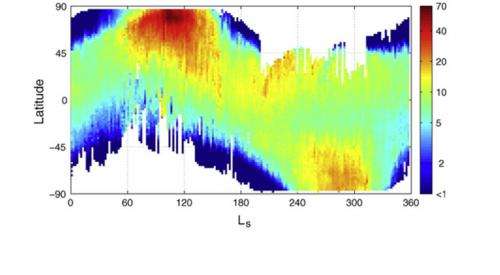Scientists 'map' water vapor in Martian atmosphere

Russian scientists from the Space Research Institute of the Russian Academy of Sciences and the Moscow Institute of Physics and Technology (MIPT), together with their French and American colleagues, have created a 'map' of the distribution of water vapour in Mars' atmosphere. Their research includes observations of seasonal variations in atmospheric concentrations using data collected over ten years by the Russian-French SPICAM spectrometer aboard the Mars Express orbiter. This is the longest period of observation and provides the largest volume of data about water vapour on Mars.
The first SPICAM (Spectroscopy for Investigation of Characteristics of the Atmosphere of Mars) instrument was built for the Russian Martian orbiter Mars 96, which was lost due to an accident in the rocket launcher.
The new updated version of the instrument was built with the participation of the Space Research Institute as part of the agreement between RosCosmos and the French space agency CNES for the Mars Express orbiter. The apparatus was launched on June 2, 2003 from the Baikonur Cosmodrome using a Russian Soyuz rocket launcher with a Fregat propulsion stage. At the end of December 2003, Mars Express entered a near-Mars orbit and since then has been operating successfully, collecting data on the planet and its surroundings.
Staff of the Space Research Institute and MIPT, including Alexander Trokhimovsky, Anna Fyodorova, Oleg Korablyov and Alexander Rodin, together with their colleagues from the French laboratory LATMOS and NASA's Goddard Center, have analysed a mass of data obtained by observing water vapour in Mars' atmosphere using an infrared spectrometer that is part of the SPICAM instrument over a period of five Martian years (about 10 Earth years as a year on Mars is equal to 1.88 Earth years).
Conditions on Mars—low temperatures and low atmospheric pressure—do not allow water to exist in liquid form in open reservoirs as it would on Earth. However, on Mars, there is a powerful layer of permafrost, with large reserves of frozen water concentrated at the polar caps. There is water vapour in the atmosphere, although at very low levels compared to the quantities experienced hereon Earth. If the entire volume of water in the atmosphere was to be spread evenly over the surface of the planet, the thickness of the water layer would not exceed 10-20 microns, while on Earth such a layer would be thousands of times thicker.
Data from the SPICAM experiment has allowed scientists to create a picture of the annual cycle of water vapour concentration variation in the atmosphere. Scientists have been observing the atmosphere during missions to Mars since the end of the 1970s in order to make the picture more precise, as well as traceits variability.
The content of water vapour in the atmosphere reaches a maximum level of 60-70 microns of released water in the northern regions during the summer season. The summer maximum in the southern hemisphere is significantly lower—about 20 microns. The scientists have also established a significant, by 5-10 microns, reduction in the concentration of water vapour during global sandstorms, which is probably connected to the removal of water vapour from the atmosphere due to adsorption processes and condensation on surfaces.
"This research, based on one of the longest periods of monitoring of the Martian climate, has made an important contribution to the understanding of the Martian hydrological cycle—the most important of the climate mechanisms which could potentially support the existence of biological activity on the planet," said co-author of the research Alexander Rodin, deputy head of the Infrared Spectroscopy of Planetary Atmospheres Laboratory at MIPT and senior scientific researcher at the Space Research Institute.
More information: www.sciencedirect.com/science/ … ii/S0019103514005466
Provided by Moscow Institute of Physics and Technology




















